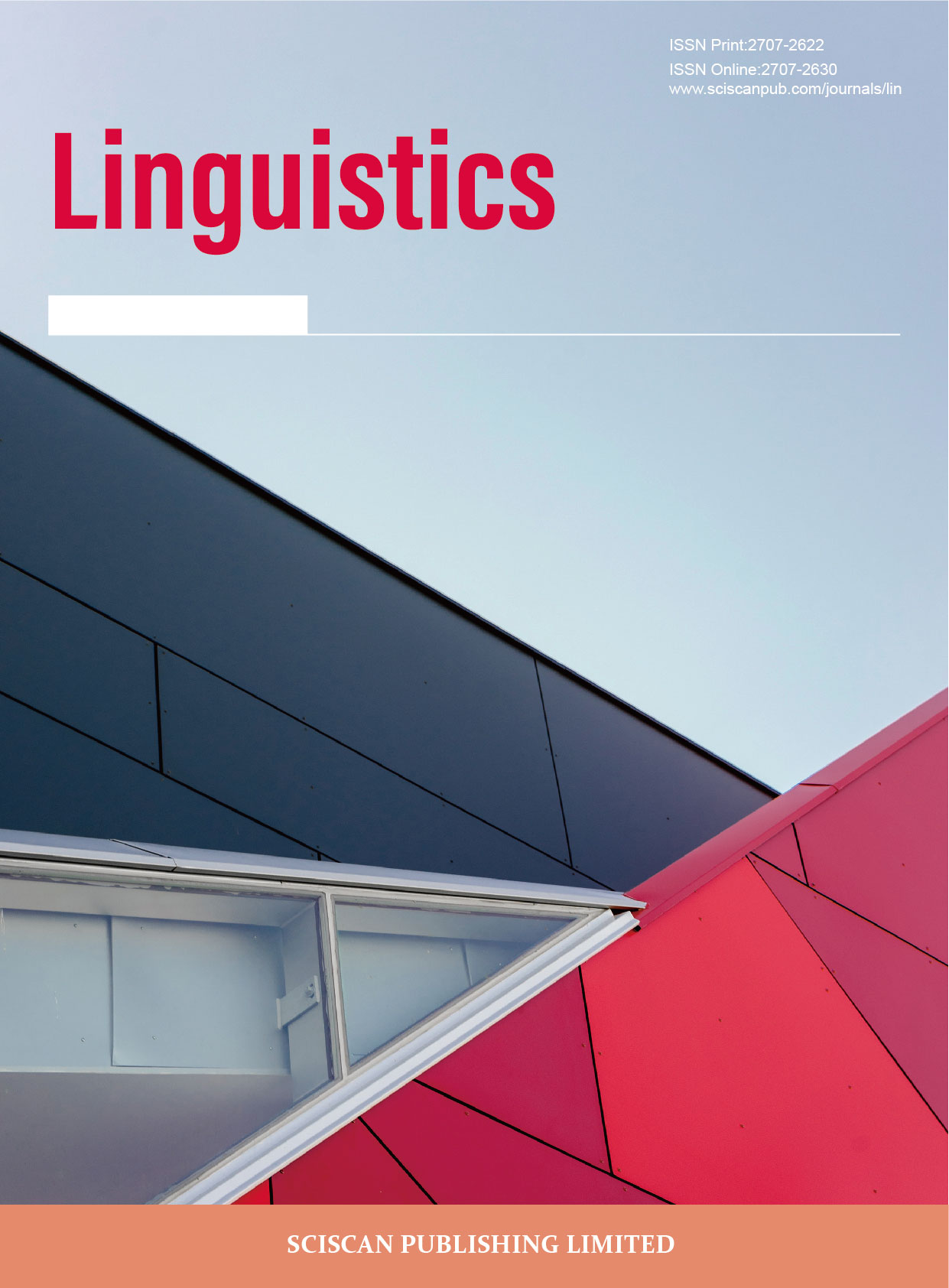双语者的第二语言加工 与母语者相同吗?——来自藏—汉双语者汉字词识别进程的证据
Does Non-native Bilinguals Process Second Language alike Native?—Evidence from Tibetan-Mandarin Bilinguals’ Chinese Word Recognition
- Authors: 韩海宾 崔占玲
-
Information:
河北师范大学教育学院,石家庄
-
Keywords:
Tibetan-Mandarin Bilingual; Second language; Word recognition; Time course藏—汉双语者; 第二语言; 字词识别; 时间进程
- Abstract: By conducting the true-pseudo words judgment task, this study examined the time course of Tibetan-Chinese bilinguals recognizing Chinese characters and words as their second language. The results show that: (1) the time course of Tibetan–Mandarin bilinguals’ Chinese character recognition basically follows the same order: semantic, phonological, and graphic information; (2) Language proḀciency does not have an impact on the process of Tibetan-Chinese bilinguals recognizing Chinese words. The entire study suggests that the time course of Chinese word recognition differs between Tibetan-Chinese bilinguals and native Chinese speakers. In other words, the second language processing of bilingual individuals diᴀers from that of native speakers. These research findings prompt us to delve deeper into the study of second language processing in bilingual individuals and have significant implications for bilinguals’ second language teaching. 采用真假字词识别的经典实验范式,考察了藏—汉双语者识别第二语言汉字词的时间进程。结果表明:(1)藏—汉双语者的汉字词识别时间进程涉及语义、语音和字形等因素。(2)语言熟练程度对藏—汉双语者的汉字词识别进程没有显著影响。整个研究表明,藏—汉双语者的汉字词识别时间进程与汉语母语者不同,即双语者的第二语言加工过程与该语言的母语者存在差异。这一研究结果促使我们深入思考双语者的第二语言加工研究,并为外语教学研究提供重要的参考价值。
- DOI: https://doi.org/10.35534/lin.0502007
- Cite: 韩海宾,崔占玲.双语者的第二语言加工与母语者相同吗?——来自藏—汉双语者汉字词识别进程的证据[J].语言学,2023,5(2):69-80.
1 引言
双语者的语言认知特点一直备受关注,是语言认知领域的热点。目前,研究者开始关注双语者的非母语加工过程,并围绕着双语者的第二语言(L2)加工与该语言母语者的母语(L1)加工为何以及如何不同而展开(Frenck-Mestre,2005),但对双语者的L2加工及其与该语言母语者L1加工的差异尚缺乏深入的研究。我国拥有众多少数民族,对于少数民族学生汉字词加工特点的研究也相对较少,主要集中在小学生群体。探讨这一问题不仅可以加深我们对双语者第二语言加工机制的认识,还能提高少数民族学生的汉语学习效率。
以往研究从不同文字的大脑加工机制(Nelson et al.,2009;Perfetti et al.,2007;Simos et al.,2005;Tan et al.,2005)、双语者两种语言之间的相互影响(高悦 等,2015)等方面展开了研究,并发现对同一种语言而言,作为L2时的加工可能不同于其作为L1时的加工,这种差异可能源自两种语言不同的文字特点以及两种语言本身的巨大差异。此外,双语者L2的习得过程不同于该语言母语者L1的习得过程(Bailey et al.,1974;Dulay and Burt,1974;Midgley et al.,2009)。母语习得与成人二语习得在习得年龄、习得机制、习得模式、习得环境等方面都存在很大差异(江新,2003;江新、柳燕梅,2004;马炳军、刘芳芳,2014;曾逸群,2008),这也可能导致双语者的L2加工不同于该语言的母语者。在影响L2加工的因素上,研究者们从第二语言熟练程度、母语加工方式以及实验任务等角度也为探讨双语者的L2加工机制及与该语言母语者的异同提供了依据(张金桥、王燕,2010;张晓戍,2012;赵永桂,2009)。例如,在汉语熟练程度上,赵永桂(2009)发现,识别高频汉字词时,汉语熟练的留学生的字词识别激活顺序是音→义,字形自始至终没有得到激活;汉语不熟练的留学生则激活字形和语义,却未激活语音信息。这一研究结果与汉语母语者在激活高频汉字时由字形直接达到义的激活过程不同,证实了母语加工方式和第二语言熟练程度对双语者L2加工的影响。
然而,虽然研究者发现了L2加工进程与汉语母语者的差异,但他们对结果的讨论都基于“双语者的L2加工与该语言的母语者相同”的假设。实际上,并非所有的研究结果都能够得到合理的解释。例如,对双语者为何未激活字形信息,研究
者归因于SOA选取不当(赵永桂,2009)或启动效应具有“较窄的SOA窗口”(即,只有在狭小时间范围内才能产生)(张晓戍,2012)。然而,双语者的L2加工果真与该语言的母语者相同吗?语言学家认为,基于L1加工得出的词汇识别理论并不能解释该语言作为L2时的识别过程(Brysbaert and Van Wijnendaele,2003)。
在本研究中,我们抛开双语者的第二语言加工与该语言母语者基本相同的基本假设,选取藏—汉双语者为被试,通过考察藏—汉双语者汉字词识别的时间进程,试图从字词水平上揭示双语者的L2加工是否类似于该语言的母语者。对双语者的研究发现,L2熟练程度和母语加工方式是影响双语者语言加工的主要因素,汉语词汇信息与语义信息之间的联系强度会随着藏—汉双语者汉语熟练程度的变化而变化。那么,汉语熟练程度是否会影响藏—汉双语者的汉字词加工?藏文字作为拼音文字的加工方式是否会影响第二语言汉语的加工?我们的预期假设是:藏—汉双语者与汉语母语者的汉字词加工过程不同,无论藏—汉双语者的汉语水平如何,在识别汉字词时,都最先激活语义信息而不是字形信息。
2 实验1 不熟练藏—汉双语者的汉字词识别的时间进程
2.1 研究方法
(1)被试
我们选取了某民族学院藏族学生72名(男性26名,女性46名),平均年龄16.03岁。他们在内地已经生活了4年9个月(以藏语为母语,平均接触汉语的年龄为6.94岁)。他们的普通话水平达到了二级乙等及以上水平。实验前被试自评其汉语熟练程度,评分范围从1到7,其中7代表非常熟练,1代表非常不熟练。结果显示,被试的汉语平均熟练程度为3.90。所有被试都第右利手,并且视力或矫正视力正常。
(2)实验设计
本实验采用了4×4混合设计。自变量包括启动词与目标词之间的关系类型(形似字对、音同字对、义近字对和无关字对)以及SOA(自启动字开始呈现到目标字呈现之间的时间间隔,包括50 ms、75 ms、100 ms、125 ms四种)。测验词类型为被试内变量,SOA条件为被试间变量。因变量包括被试对目标字的反应时和错误率。
(3)实验材料
实验材料包括启动字和目标字。依据启动字和目标字的关系类型,将材料分为形似字对、音同字对、义近字对以及字形、语音、语义均无关的无关字对。字对的笔画数和结构均已控制。实验材料主要参考了周晓林等人(2003)和赵永桂(2009)实验所用的材料。先将两个研究所用材料汇总,组成本研究的自评量表1。请20名藏族学生在7点量表上评定形近字对和义近字对的字形相似或语义相近程度,其中,7代表“非常相似或相近”,1代表“非常不相似或不相近”。从中选取形似字对和义近字对各15对。在此基础上,添加同等数量的音同字对和无关字对构成评定量表2。将材料打乱后,由23名藏族学生对所有材料进行7点量表的熟练度评定。依据评定结果,从中选取熟悉各类实验材料各12对,共48对。所选材料的平均熟练程度为6.27,音同字对、形似字对、义近字对和无关字对的平均熟练度分别为6.21、6.29、6.37和6.33,平均熟悉性差异不显著,F(3,92)=0.51,p>0.05。另外,所选字对的形似和语义相似度分别为5.67、6.00。t检验表明,形似字对的字形相似程度和义近字对的语义相似程度都显著高于无关控制组。并且,字形相似字对和语义相近字对之间的相关程度也不显著,t=1.48,p>0.05。
填充项目为与目标字数量相同的假字。假字是在真字上增加或减少笔画、替换真字偏旁结构生成的无语义和发音且与启动字字形上不相近的材料。每个启动类型组另有8对字作为练习,其呈现方式和时间间隔与正式实验类似。
表1 实验1材料举例
Table 1 Material examples in experiment 1
|
特征 |
无关字对组 |
形似字对 |
音同字对 |
义近字对 |
|
材料举例 |
统—选 |
休—体 |
斥—赤 |
父—母 |
|
平均笔画数 |
8.94 |
7.58 |
8.14 |
7.50 |
|
平均熟悉度 |
6.33 |
6.29 |
6.21 |
6.37 |
(4)实验程序
实验材料由E-prime实验系统控制随机呈现在计算机屏幕的中央。在练习阶段,被试按键后会有红色字体的反馈结果出现,若练习错误率较高,则重新开始练习直到正确率较高为止。正式实验后将不会有反馈出现。实验个别进行,每个被试由一个主试在单独的房间在旁监视。被试首先阅读指导语,明白实验任务后按Q键进入练习。在实验过程中,被试坐在距离计算机50 cm处,每个trial中,都是首先呈现红色注视点(“+”标记),持续500 ms,之后随即呈现启动字,依据SOA条件呈现不同时间(分别是50 ms、75 ms、100 ms或125 ms),只要求被试仔细、认真识别启动字,不做任何反应;然后呈现目标字,要求被试判断该字是真字还是假字。如果是真字,按F键;如果是假字,按J键(被试间平衡左右手反应键)。被试2500 ms仍未作出反应,目标字自动消失,结果按错误处理。空屏500 ms后,进入下一试次,直至该阶段结束。被试自行控制不同阶段之间的休息时间。计算机自动记录被试的反应时,计时单位为ms,误差为±1ms。
2.2 实验结果
全部数据经SPSS软件处理,统计结果均以M±SD表示。统计时舍去M±3SD之外的数据,删去总数据的1.45%。被试对不同字对做出判断的平均反应时和平均错误率见表2和表3。
表2 不熟练藏—汉双语者四类字对的平均反应时(ms)(M±SD)
Table 2 The mean reaction time in nonproficiency bilinguals (ms) (M±SD)
|
SOA(ms) |
无关控制组 |
形似字对组 |
音同字对组 |
义近字对组 |
|
50 |
746±99 |
745±107 |
689±105 |
658±78 |
|
75 |
779±48 |
755±79 |
678±40 |
680±39 |
|
100 |
795±76 |
771±59 |
706±57 |
697±59 |
|
125 |
798±61 |
775±47 |
696±72 |
698±89 |
表3 不熟练藏—汉双语者四种材料的平均错误率(%)(M±SD)
Table 3 The mean error rates in nonproficiency bilinguals (ms) (M±SD)
|
SOA(ms) |
无关控制组 |
形似字对组 |
音同字对组 |
义近字对组 |
|
50 |
6.94±6.26 |
6.02±5.81 |
4.78±6.23 |
3.09±5.03 |
|
75 |
4.94±4.32 |
1.70±2.36 |
4.78±6.23 |
2.32±3.23 |
|
100 |
5.25±5.12 |
4.32±3.59 |
3.24±2.89 |
1.08±1.39 |
|
125 |
5.86±4.94 |
4.32±4.14 |
3.82±3.42 |
2.12±1.86 |
反应时的方差分析表明,材料类型的主效应显著,F1(3,204)=52.50,p<0.001,η2=0.436,F2(3,414)=108.06,p<0.001,η2=0.448,被试对义近材料和音同材料的反应显著快于形似材料和无关材料。SOA的主效应被试内分析不显著,F1(2,57)=0.89,p>0.05,项目分析显著,F2(3,138)=14.99,p<0.05,η2=0.221,材料类型和SOA的交互作用不显著,F1(9,204)=0.46,p>0.05,F2(9,414)=0.94,p>0.05。错误率的方差分析表明,材料类型的主效应显著,F1(3,204)=11.06,p<0.001,η2=0.145,F2(3,414)=16.53,p<0.001,η2=0.104。错误率由高到低分别为无关材料、形似材料、音同材料、义近材料。无关材料的错误率显著高于其他材料,p<0.001,形似材料的错误率显著高于音同材料和义同材料的错误率,p<0.001,音同材料的错误率显著高于义同材料,p<0.001。SOA的主效应被试分析不显著,F1(3,68)=1.39,p>0.05,项目分析显著,F2(3,138)=7.32,p<0.001。材料类型和SOA的交互作用也不显著,F1(9,204)=1.48,p>0.05,F2(9,414)=1.14,p>0.05。
实验1表明,无论在哪一种SOA下,不熟练的藏—汉双语者识别汉字词时,都是最先激活语义信息和语音信息,并且显著快于字形信息的激活,这一结果显著不同于汉语母语者由形到义的识别进程。
3 实验2 熟练藏—汉双语者的汉字词识别时间进程
3.1 研究方法
(1)被试
藏族学生72名(男28名,女42名)。平均年龄19.73岁。内地生活时间平均为9年零10个月(接触汉语的平均年龄为6.55岁),被试汉语熟练程度(M=6.29)显著高于实验1的被试(M=3.90),t=30.07,p<0.001。在其他方面,实验2与实验1被试基本相同。
(2)实验设计(同实验1)
(3)实验材料和程序(同实验1)
3.2 实验结果
统计时舍去M±3SD之外的数据,删去总数据的1.13%。被试对不同字对的平均反应时和平均错误率见表4、5。
表4 熟练藏—汉双语者对四种材料的平均反应时(ms)(M±SD)
Table 4 The mean reaction time in proficiency bilinguals (ms) (M±SD)
|
SOA(ms) |
无关控制组 |
形似字对组 |
音同字对组 |
义近字对组 |
|
50 |
717±96 |
702±83 |
639±76 |
651±63 |
|
75 |
623±41 |
609±62 |
595±53 |
552±51 |
|
100 |
655±52 |
634±53 |
589±39 |
579±63 |
|
125 |
664±51 |
638±56 |
606±62 |
573±42 |
表5 熟练藏—汉双语者对四种材料的平均错误率(%)(M±SD)
Table 5 The mean error rates in proficiency bilinguals (ms) (M±SD)
|
SOA(ms) |
无关控制组 |
形似字对组 |
音同字对组 |
义近字对组 |
|
50 |
6.02±5.33 |
2.62±2.77 |
2.47±3.55 |
2.93±3.87 |
|
75 |
6.04±5.91 |
6.54±6.66 |
2.45±3.09 |
2.29±3.57 |
|
100 |
5.23±3.91 |
6.04±4.31 |
1.96±2.56 |
1.14±1.98 |
|
125 |
6.37±4.14 |
5.55±3.80 |
4.08±4.06 |
1.96±1.90 |
反应时的方差分析表明,材料类型的主效应显著,F1(3,204)=39.09,p<0.001,η2=0.365,F2(3,420)=108.41,p<0.001,η2=0.436,均数比较表明,被试对义近材料和音同材料的反应显著快于形似材料和无关材料。SOA的主效应显著,F1(3,68)=11.24,p<0.001,η2=0.331,F2(3,140)=72.56,p<0.001,η2=0.609,被试在SOA=75 ms时反应最快(M=594 ms),在SOA=50 ms时
(M=677 ms)反应最慢。材料类型和SOA的交互作用被试内分析不显著,
F1(9,204)=1.10,p>0.05,项目分析显著,F2(9,420)=2.80,p<0.005,η2=0.057。
错误率的方差分析表明,材料类型的主效应显著,F1(3,204)=17.47,p<0.001,
η2=0.204,F2(3,411)=13.93,p<0.001,η2=0.105,义近材料(M=2.09%)和音
同材料(M=2.74%)的错误率最低,形似材料(M=5.15%)和无关材料(M=5.92%)
的错误率最高。SOA的主效应不显著,F1(3,68)=0.98,p>0.05,F2(3,137)=2.03,
p>0.05。材料类型和SOA的交互作用不显著,F1(9,204)=1.14,p>0.05,
F2(9,411)=1.36,p>0.05。实验2表明,无论在哪一种SOA下,熟练藏—汉双语者识别汉字词时也是先激活语义信息,最后才激活字形信息。
为了了解汉语熟练程度对藏—汉双语者汉字词识别进程的影响,对实验1、实验2的结果做了综合分析。结果表明,汉语熟练被试的汉字识别速度
(M=627 ms)显著快于汉语不熟练被试(M=729 ms),F1(1,136)=154.39,p<0.001,η2=0.532,F2(1,278)=94.95,p<0.001,η2=0.765。但汉语熟练程度对藏—汉双语者汉字识别早期字形、语音和语义信息的激活顺序没有显著影响,字形信息在藏—汉双语者对汉字识别的早期阶段并未激活。
4 讨论
本研究采用了真假词判断任务,首先考察了汉语熟练程度高的藏—汉双语者的汉字识别进程,发现不论在哪一种SOA下,不熟练的藏—汉双语者在识别汉字时,最先激活的是语义信息和语音信息,并且显著快于字形信息的激活。对于熟练的双语者来说,结果也相似,都是首先激活语义和语音,字形信息的激活相对较晚。总体而言,汉语熟练程度对藏—汉双语者的汉字识别没有显著影响,藏—汉双语者在第二语言汉字词识别中的相对时间进程是语义、语音,最后才是字形信息。
本研究结果与留学生汉字识别时间进程的研究结论似乎不一致。张金桥和王燕(2010)的结论是,汉语水平一般的韩国留学生识别高频汉字词的时序是
形→义→音,印尼留学生则是形→音→义。赵永桂(2009)发现,汉语水平影响双语者第二语言的字词识别进程,汉语水平高的留学生识别高频汉字词时同时激活了字形和语义信息,低水平留学生的激活时间进程是音→义,未激活字形信息。但是,仔细分析以往研究的实验数据,笔者发现,本研究结果与上述研究的结果基本一致。例如,在赵永桂(2009)的研究中,低水平留学生识别高频汉字时未激活字形信息,高水平留学生在识别高频汉字词的早期阶段(57 ms),
字形与语义信息同时得到了激活,当SOA=85 ms时,只有语义信息得到激活。但是,为何研究者没有得出语义信息最先激活、字形信息可能未激活的结论呢?一个可能的原因是:研究者在分析实验数据时的基本假设是双语者第二语言的字词识别进程与母语者相同。因此,对与汉语母语者不同的汉字识别进程,研究者只从“较窄的SOA窗口”(张晓戍,2012)、SOA影响(赵永桂,2009)等方面分析,未意识到双语者第二语言的字词识别进程可能与母语者的加工进程有区别。有研究者指出,来自母语(第一语言)字词识别的理论不能用来解释双语者的L2识别,因为双语者的L2字词识别受到L1和L2两种语言的共同影响(Brysbaert and Van Wijnendaele,2003)。
本研究的结果还得到了第二语言为英语的实验的支持。张敏(2011)通过考察汉—英双语者识别高、低频英文词的时间进程发现,无论实验任务是否与语义通达有关,无论目标字字频高低,汉—英双语者在识别英文词时都是首先激活了该字词的语义信息。杨闰荣(2007)对中等熟练程度的汉—英双语者英文词语义通达的研究发现,被试对义近字对的英文词反应最快,错误率最低。此外,本实验的结果与实验结束后对被试的访谈结果一致。在访谈中,当问及被试看到汉字后首先想到该字的什么信息时,所有被试的回答基本一致:首先想到该字的意思,而不是该字的字形信息。
本研究采用了真假字词判断的经典范式系统,探讨了藏—汉双语者的汉字词识别时间进程,发现与汉语母语者不同,藏—汉双语者识别汉字的时间进程是义→音→形。这一结果表明藏—汉双语者的汉字识别时间进程不同于汉语母语者,不支持以往关于双语者L2识别时间进程的预定假设。那么,双语者的L2加工进程不同于母语者又意味着什么?是否说明了双语者的L2加工在本质上与该语言的母语者不同?笔者认为,无论是双语者还是单语者,无论是加工L2还是加工L1,言语理解或言语产生的实质应该是相同的。然而,由于双语者的L2习得过程不同于母语者,并且双语者两种语言之间存在相互影响、加工L2的认知资源有限以及学习L2时的大脑成熟度不同于L1等因素,可能导致双语者的L2加工过程不同于该语言的母语者,特别是在字词加工的早期阶段。因此,对双语者L2加工机制的深入探讨无疑将有助于选择双语领域研究范式并对研究结果进行理论解释。
5 结论
综上所述,藏—汉双语者的汉字词识别时间进程是语义,其次为语音,最后是字形信息的激活。语言熟练程度对藏—汉双语者的汉字词识别进程没有影响。双语者的L2加工过程不同于该语言母语者。
参考文献
[1]高悦,魏娜,王正科,等.汉—英汉—英儿童双语者母语和二语加工的相互作用:来自神经机制方面的证据[J].心理学报,2015(12):1.
[2]江新.不同母语背景的外国学生汉字知音和知义之间关系的研究[J].语言教学与研究,2003(6):51-57.
[3]江新,柳燕梅.拼音文字背景的外国学生汉字书写错误研究[J].世界汉语教学,2004(1):60-70.
[4]马炳军,刘芳芳.儿童母语习得与成人二语习得差异研究述评[J].阜阳师范学院学报(社会科学版),2014(3):31-34.
[5]杨闰荣.汉—英汉—英双语者中英文词汇加工的ERP对比研究[D].大连:辽宁师范大学,2007.
[6]曾逸群.拼音文字为背景的外籍学生对汉字形音认知的倾向调查[J].暨南大学华文学院学报,2008(3):43-52.
[7]张金桥,王燕.韩国,印尼留学生汉字识别中形音义的激活[J].心理学探新,2010,30(6):36-44.
[8]张敏.中英双语者英文书面字词识别的心理表征与激活进程的研究[D].南昌:江西师范大学,2011.
[9]张晓戍.不同实验任务下东南亚留学生汉字识别中形音义的激活[D].福州:福建师范大学,2012.
[10]赵永桂.留学生高频汉字识别过程中形音义激活的时间进程[D].广州:暨南大学,2009.
[11]周晓林,曲延轩,庄捷.再探汉字加工中语音,语义激活的相对时间进程[J].心理与行为研究,2003,1(4):241-247.
[12]Bailey N,Madden C,Krashen S D.Is there a “natural sequence” in adult second language learning?[J].Language Learning,1974,24(2):235-243.
[13]Brysbaert M,Van Wijnendaele I.The importance of phonological coding in visual word recognition:Further evidence from second-language processing[J].Psychologica belgica,2003,43(4):249-258.
[14]Dulay H C,Burt M K.Natural sequences in child second language acquisition1[J].Language Learning,1974,24(1):37-53.
[15]Frenck-Mestre C.Eye-movement recording as a tool for studying syntactic processing in a second language:A review of methodologies and experimental findings[J].Second Language Research,2005,21(2):175-198.
[16]Midgley K J,Holcomb P J,Grainger J.Masked repetition and translation priming in second language learners:A window on the time-course of form and meaning activation using ERPs[J].Psychophysiology,2009,46(3):551-565.
[17]Nelson J R,Liu Y,Fiez J,et al.Assimilation and accommodation patterns in ventral occipitotemporal cortex in learning a second writing system[J].Human brain mapping,2009,30(3):810-820.
[18]Perfetti C A,Liu Y,Fiez J,et al.Reading in two writing systems:Accommodation and assimilation of the brain’s reading network[J].Bilingualism:Language and Cognition,2007,10(2):131-146.
[19]Simos P,Billingsley-Marshall R,Sarkari S,et al.Brain mechanisms supporting distinct languages[J].Learning Disabilities Research & Practice,2005,20(1):31-38.
[20]Tan L H,Laird A R,Li K,et al.Neuroanatomical correlates of phonological processing of Chinese characters and alphabetic words:A meta-analysis[J].Human brain mapping,2005,25(1):83-91.
















